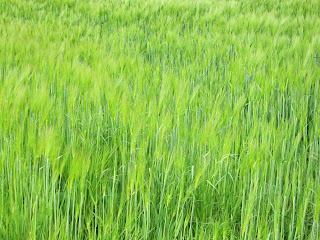 The impressive farm house and buildings at Aishe Barton
The impressive farm house and buildings at Aishe Barton Andrew Baker checking calving cows
Andrew Baker checking calving cows Winter sown barley in head
Winter sown barley in head Red Ruby Devon cows and calves
Red Ruby Devon cows and calves
The business end of the trip has started. Picked up a sporty, bright red, brand new Astra 2.0l diesel yesterday in Exeter. The Navman and I had some issues finding the village of Silverton but I don't remember typing in "find all tiny country lanes" as a directive. Tractors, sprayers, silage carts all coming the other way at speed in an absolute miniscule space. Reverse is almost the new forward.
The farm at Silverton, in the middle Exe river valley is 660 acres, about half cropped and the rest either for a herd of Devon cattle (what else in this county) and Dorper sheep (self-shearing or maybe just untidy individuals) with a lot of country set aside for woodlots, regeneration areas for food for birds and animals. The farmer, Andrew Baker, is part of the LEAF organisation (Linking Environment and Farming) which educates the public through a series of Farm Open days and visits. He is passionate about the way he and his assistant farm the country, and coming from a non-farm background (engineering) looked for the most appropriate methods rather than just carry on with tradition.
He has established an amazing length of hedgerows (over 13km) on the fence lines to encourage insects and resident birds for pest control during cropping phases, and pointed out over 20 different bird species during our drive. Crop margins of over 2 metres are left inside every cropped paddock and maintained to give grasses a chance to grow without the effect of sprays and it allows birds to have a shorter hunting zone outside of the crop.
He has a 25 metre tall wind generator on top of a hill and I really would like to see more of these in Australian paddocks. He did mention at one stage that the noise of the vanes moving was "the sound of money".
What we call canola is still known as oilseed rape here, and it is outstanding in its yellow flowers at the moment. Wheat is not yet in head, but barley is fully in head and oats still in the leafy stages. Most cereal grain grown on the farm is retained then put through a roller to provide feed for shedded livestock in winter. The cows are particularly quiet as they are around people big time when they are in the barns over winter. The sheeps ran up to him when he whistled, and they use quiet ones to help load the others into trailers for movement between paddocks.
The farm is in 8 different blocks within 3 miles of the house except a hay paddock on the river about 5 miles away.
The house has, reputedly, the longest thatched roof in Devon and due to the fact that there is a barn attached to one end, it is supposed to be the largest semi-detached dwelling in southern England (it were never proven!).
I will attach some photos of the farm
Cheers
Alan
No comments:
Post a Comment